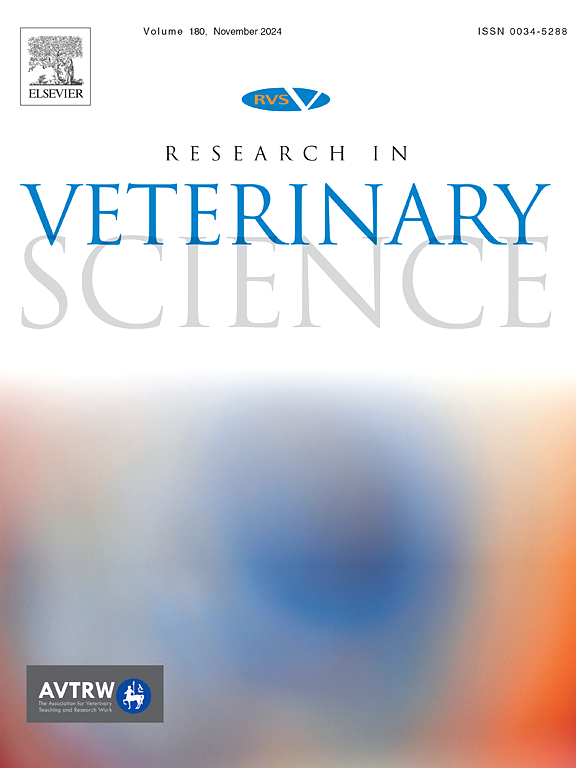Non-invasive biomarkers for monitoring intestinal health in broilers – A systematic review
IF 2.2
3区 农林科学
Q1 VETERINARY SCIENCES
引用次数: 0
Abstract
This systematic review aimed to identify and evaluate non-invasive biomarkers for assessing gut health in broilers, following PRISMA guidelines and using the PICO strategy. A comprehensive search was conducted in Web of Science, Scopus, and PubMed for papers written in English, Portuguese, and Spanish. After screening 1196 papers, 21 studies met the inclusion criteria and were included in the review. The studies, primarily conducted in Europe, Oceania, and North America, were published between 2003 and 2024. The review highlighted the intestinal microbiota as the most studied non-invasive biomarker, using excreta, cloacal swabs, poultry litter, and poultry dust as sample sources. Poultry litter and dust were identified as promising non-invasive alternatives for assessing gut microbiota, with excreta being the most commonly used sample type. Biomarkers like ovotransferrin, lipocalin-2, and calprotectin are under investigation for broiler gut health assessment. Cecal samples were frequently used as a gold standard for comparison. The choice of reference databases, such as SILVA and Greengenes, varied among studies, which may have influenced taxonomic classification and microbial group abundance. Methodological quality varied across studies, with a mix of observational and experimental designs. Many studies involved comparative analyses related to dietary and sanitary challenges, though inconsistencies in reporting diet composition and performance data were observed. In conclusion, many non-invasive biomarkers are under investigation for broiler gut health assessment, but challenges remain in validating these markers due to the complexity of the gut ecosystem. These challenges emphasize the need for rigorous study design, thorough data collection, and standardized protocols.
肉鸡肠道健康监测的非侵入性生物标志物系统综述
本系统综述旨在根据PRISMA指南和PICO策略,鉴定和评估用于评估肉鸡肠道健康的非侵入性生物标志物。我们在Web of Science、Scopus和PubMed中对英语、葡萄牙语和西班牙语的论文进行了全面的搜索。在对1196篇论文进行筛选后,有21篇研究符合纳入标准,被纳入本综述。这些研究主要在欧洲、大洋洲和北美进行,发表于2003年至2024年之间。该综述强调肠道微生物群是研究最多的非侵入性生物标志物,使用排泄物、肛肠拭子、家禽垃圾和家禽粉尘作为样本来源。家禽垃圾和灰尘被确定为评估肠道微生物群的有前途的非侵入性替代方法,排泄物是最常用的样本类型。生物标志物如卵转铁蛋白、脂钙素-2和钙保护蛋白正在研究中,用于肉鸡肠道健康评估。盲肠样本经常被用作比较的金标准。参考数据库的选择,如SILVA和Greengenes,因研究而异,这可能影响了分类分类和微生物群丰度。不同研究的方法质量各不相同,混合了观察和实验设计。许多研究涉及与饮食和卫生挑战相关的比较分析,尽管观察到报告饮食组成和性能数据不一致。总之,许多用于肉鸡肠道健康评估的非侵入性生物标志物正在研究中,但由于肠道生态系统的复杂性,在验证这些标志物方面仍然存在挑战。这些挑战强调了严格的研究设计、全面的数据收集和标准化方案的必要性。
本文章由计算机程序翻译,如有差异,请以英文原文为准。
求助全文
约1分钟内获得全文
求助全文
来源期刊

Research in veterinary science
农林科学-兽医学
CiteScore
4.40
自引率
4.20%
发文量
312
审稿时长
75 days
期刊介绍:
Research in Veterinary Science is an International multi-disciplinary journal publishing original articles, reviews and short communications of a high scientific and ethical standard in all aspects of veterinary and biomedical research.
The primary aim of the journal is to inform veterinary and biomedical scientists of significant advances in veterinary and related research through prompt publication and dissemination. Secondly, the journal aims to provide a general multi-disciplinary forum for discussion and debate of news and issues concerning veterinary science. Thirdly, to promote the dissemination of knowledge to a broader range of professions, globally.
High quality papers on all species of animals are considered, particularly those considered to be of high scientific importance and originality, and with interdisciplinary interest. The journal encourages papers providing results that have clear implications for understanding disease pathogenesis and for the development of control measures or treatments, as well as those dealing with a comparative biomedical approach, which represents a substantial improvement to animal and human health.
Studies without a robust scientific hypothesis or that are preliminary, or of weak originality, as well as negative results, are not appropriate for the journal. Furthermore, observational approaches, case studies or field reports lacking an advancement in general knowledge do not fall within the scope of the journal.
 求助内容:
求助内容: 应助结果提醒方式:
应助结果提醒方式:


